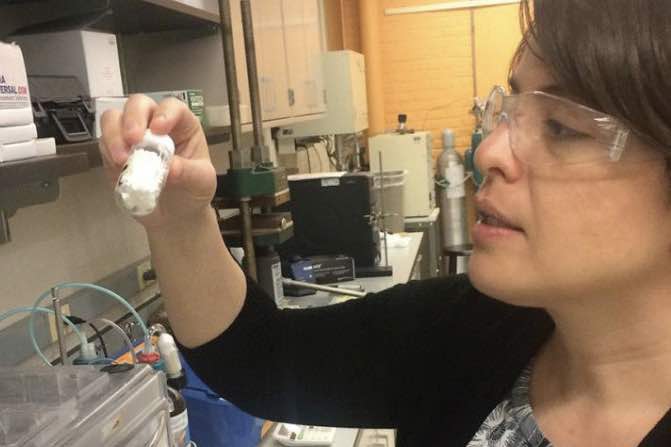HIGHLIGHTS
•
The challenge in reducing carbon dioxide is to convert the molecule from a stable linear to a bent orientation.
•
A multifunctional ionic liquid known as [EMIM] [2-CNpyr] facilitated carbon dioxide reduction when used with a copper catalyst.
•
Increasing the concentration of the ionic liquid five-fold led to a two-fold increase in carbon dioxide reduction but a further increase caused the reaction to slow down due to steric constraints.
The desire to reduce the level of the greenhouse gas carbon dioxide in the atmosphere is leading researchers to design pathways for converting this material into useful derivatives that will not contribute to global warming and help close the carbon cycle. One approach that has been under considerable study is the carbon dioxide reduction reaction, which generates useful substances such as hydrocarbons and alcohols.
In a previous TLT article,
1 a photoelectrocatalytic reduction process was developed that not only converts carbon dioxide to syngas (a combination of carbon monoxide and hydrogen), but also oxidizes waste plastic- derived ethylene glycol to glycolic acid. The process was conducted in an aqueous environment using a cobalt (II) phthalocyanine molecular catalyst. Carbon dioxide was captured by an aqueous solution of triethanolamine and then converted to syngas at a cathode that was attached to a perovskite solar cell. To minimize water oxidation, the researchers oxidized ethylene glycol, obtained from polyethylene terephthalate waste, in a separate compartment.
The challenge in reducing carbon dioxide is the stability of the molecule. Oguz Kagan Coskun, a graduate student at Case Western Reserve University in Cleveland, Ohio, says, “Carbon dioxide is a linear molecule which has a very stable structure. Finding a way to make it electrochemically active and allow the initial electron transfer to carbon dioxide is the most energy-demanding step. This high energy requirement is due to the need for the molecule to bend.”
While using an aqueous medium to reduce carbon dioxide is desirable from a sustainability standpoint, water-based systems have limited carbon dioxide capture capacity. In addition, the required potentials for the carbon dioxide reduction reaction trigger a parasitic reaction in the aqueous medium where water is converted to hydrogen gas.
An alternative approach utilized ionic liquids as the electrolyte for facilitating the carbon dioxide reduction reaction. Dr. Saudagar Dongare, postdoctoral researcher at Case Western Reserve University, says, “Functional ionic liquids are a captive medium which can chemically bind with carbon dioxide. They also have been found to modify the surface of catalytic electrodes to form unique double-layer structures. These properties enable ionic liquids to create a microenvironment with reduced potential requirements for carbon dioxide reduction and without the hydrogen evolution reaction.”
Coskun indicates that reaction of the ionic liquid cation and carbon dioxide is more complex. To gain a further understanding of how ionic liquid can promote the reduction of carbon dioxide, Coskun, Dongare and Burcu Gurkan, professor of chemical engineering at the Case Western Reserve School of Engineering
(see Figure 3), led a study with a specific ionic liquid 1-ethyl- 2-methylimidazolium 2-cyanopyrrolide, [EMIM] [2-CNpyr] that they synthesized in the laboratory.
 Figure 3. Professor Burcu Gurkan led a team that utilized a multifunctional ionic liquid as a co-catalyst with copper in facilitating the electrochemical reductionof carbon dioxide. Figure courtesy of Case Western Reserve University.
Figure 3. Professor Burcu Gurkan led a team that utilized a multifunctional ionic liquid as a co-catalyst with copper in facilitating the electrochemical reductionof carbon dioxide. Figure courtesy of Case Western Reserve University.
The carbon dioxide reduction reaction was conducted by having the gas and an ionic liquid interact above the surface of a metal electrode which acted as the catalyst. The ionic liquid selected to be used in the electrochemical carbon dioxide reduction reaction, [EMIM] [2-CNpyr], had been found to be active in facilitating the reduction of carbon dioxide in past work.
Copper was used as the catalyst because it has been found to produce hydrocarbon products with high numbers of carbon atoms while reducing carbon dioxide.
Using a variety of analytical techniques, including
in situ surface-enhanced Raman spectroscopy, electrochemical impedance spectroscopy and linear sweep voltammetry, the researchers found that the catalytic activity is governed by the concentration of the ionic liquid and a natively formed hydrogen bond donor upon chemisorption of carbon dioxide by the ionic liquid. The latter is the anionic component of the ionic liquid. This chemisorption increases the viscosity of the ionic liquid causing mass transport limitations during the reduction reaction.
The viscosity of the ionic liquid plays a role in affecting the reaction rate. To minimize this concern, acetonitrile was introduced as a solvent in the carbon dioxide reduction reaction.
The researchers evaluated the ionic liquid at concentrations ranging from 0.1 to 0.5 molar in acetonitrile. More than a two-fold increase in the reduction of carbon dioxide was realized compared to aqueous systems. When the concentration of the ionic liquid was further increased to 1.0 molar, the reaction slowed down. Gurkan says, “The reason for the reduction in reactivity is steric. As more ionic liquid is present at the copper electrode surface, a thickened double layer structure forms due to its bulky ions. This prevents carbon dioxide from reaching the metal surface effectively.”
Products identified from the carbon dioxide reduction reaction included formate, succinate, methane, ethylene and ethane. Gurkan says, “The purpose of the study was to understand the fundamentals of how the ionic liquid affected the rate of the reaction. Future work will be done to increase and understand the factors governing the selectivity.”
Additional information can be found in a recent article,
2 by visiting the Gurkan research group website (
www.energylab-cwru.com), or by contacting Gurkan at
beg23@case.edu.
REFERENCES
1.
Canter, N. (2023), “Production of synthesis gas from carbon dioxide using solar energy,” TLT,
79 (10), pp. 22-23. Available
here.
2.
Coskun, O., Dongare, S., Doherty, B., Klemm, A., Tuckerman, M. and Gurkan, B., (2024), Tailoring electrochemical CO2 reduction on copper by reactive ionic liquid and native hydrogen bond donors,”
Angewandte Chemie International Edition 63 (1), e202312163.